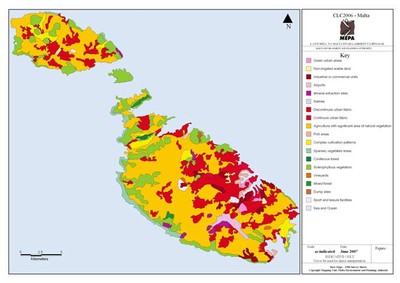Malta’s small-island state nature, high population density and location at the southern tip of Europe are important distinguishing factors that set Malta apart from many other European nations. These characteristics, particularly its strategic location, have driven much of its socio-economic and cultural history, and thus land cover (Map 1). These factors have also influenced its governance style and practices, which over the last decade have been under review in the light of the EU membership. They also influence which environmental issues are viewed with most concern. For example, the emblematic environmental issues of the eighties and nineties were mainly land-use and waste-related.

Map 1: Land cover by type (2006)
Environmental Governance
The responsibility for environment lies with the Parliamentary Secretary for Tourism, the Environment and Culture within the Office of the Prime Minister. Within this context, the Malta Environment & Planning Authority (MEPA) has the responsibility for environmental protection and development planning. In some areas, such as with respect to climate change, responsibility for environmental issues falls under another ministry – in this case the Ministry for Resources and Rural Affairs.
Environmental policy and implementation is largely carried out at national level due to the nation’s small size. However, local authorities also have an important role in environmental management. They are responsible for waste collection, management of local urban green areas, traffic management and parking, and urban embellishment. MEPA is the competent authority for implementing the 2001 Environment Protection Act, including responsibility for environmental monitoring, nature protection including area management, waste policy and regulation, and permitting and enforcing activities with the potential to cause serious pollution. MEPA is currently undergoing a reform process, which should increase resources for environmental protection.
Climate
Malta’s climate is typically Mediterranean – with long hot summers and mild winters. The islands are windswept, relatively humid (with humidity averaging 65-80 %), warm (the mean from 1990-2005 was 19.02 oC), and bright (an average of 8.07 hours of sunshine daily during the period 1990-2005).1 Average rainfall is highly variable but was 466.1 mm in this period. The islands’ natural water resources are entirely rain-fed, while over half of the drinking water produced by Malta’s major supplier is sourced from desalinated sea water (link to water chapter of TER 2008). The only mineral resources of note are Globigerina and Coralline Limestone, both of which are used in construction, a fact that gives Malta’s built heritage particular conservation interest.
In common with other Mediterranean countries, and also due to its small island Geography, Malta is particularly at risk from climate change (link to climate change chapter of Malta TER 2008). The IPPC’s Fourth Assessment Report2 states that small islands have characteristics that make them especially vulnerable to the effects of climate change, sea-level rise, and extreme weather events. Indeed, Malta is expected to suffer moderate impacts from climate change,3 mainly related to drought, deterioration of freshwater quality and availability, increased risk of floods, soil and coastal erosion, desertification, changes in sea level and biodiversity loss and degradation. With 100 % of the population living in coastal areas, mostly in densely populated coastal settlements, the challenge of climate change adaptation is a serious one for Malta.
1 National Statistics Office. 2006. Environment Statistics, Project implemented under the technical supervision of Eurostat and Plan Bleu, National Statistics Office, Malta.
2 IPCC (Intergovernmental Panel on Climate Change). 2007. Climate Change 2007: Synthesis report. An Assessment of the Intergovernmental Panel on Climate Change, IPCC.
3 MRAE (Ministry for Rural Affairs and the Environment). 2004. The First Communication of Malta to the United Nations Framework Convention on Climate Change, Report prepared by the University of Malta Physics Department (Sammut, C.V. and Micallef, A.) for the Ministry for Rural Affairs and the Environment, April 2004.
1 National Statistics Office. 2006. Environment Statistics, Project implemented under the technical supervision of Eurostat and Plan Bleu, National Statistics Office, Malta.
2 IPCC (Intergovernmental Panel on Climate Change). 2007. Climate Change 2007: Synthesis report. An Assessment of the Intergovernmental Panel on Climate Change, IPCC.
3 MRAE (Ministry for Rural Affairs and the Environment). 2004. The First Communication of Malta to the United Nations Framework Convention on Climate Change, Report prepared by the University of Malta Physics Department (Sammut, C.V. and Micallef, A.) for the Ministry for Rural Affairs and the Environment, April 2004.

Document Actions
Share with others